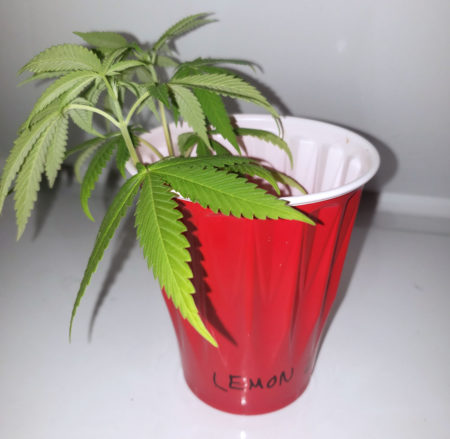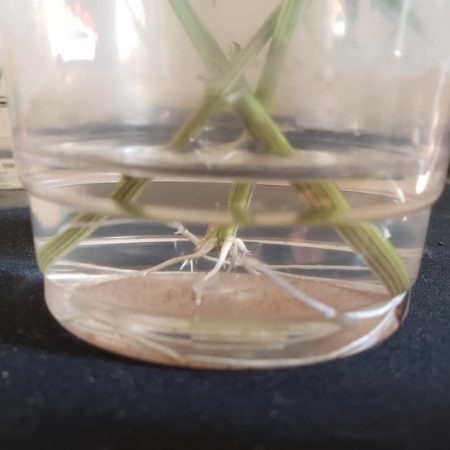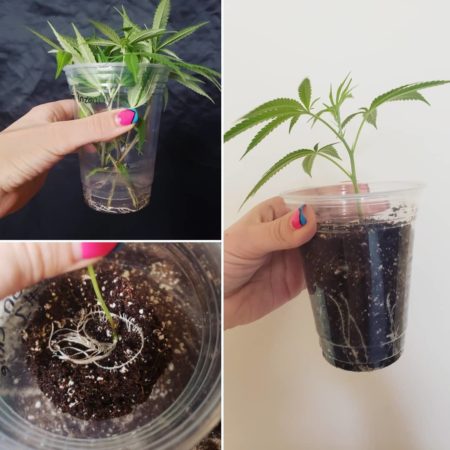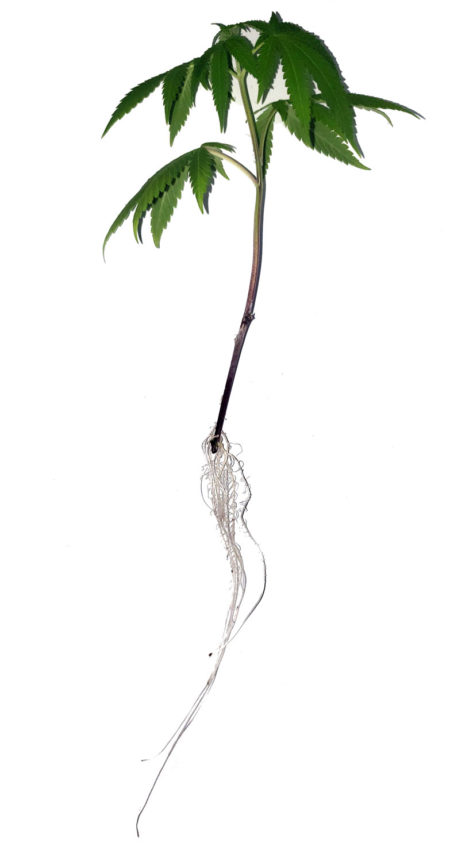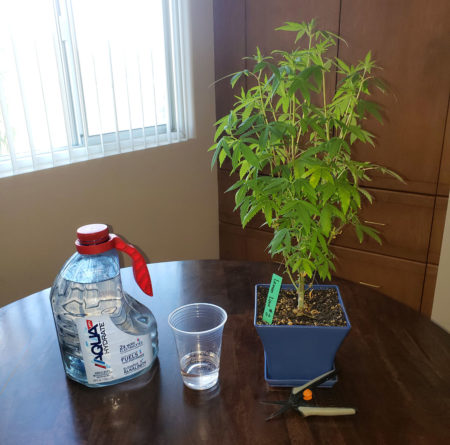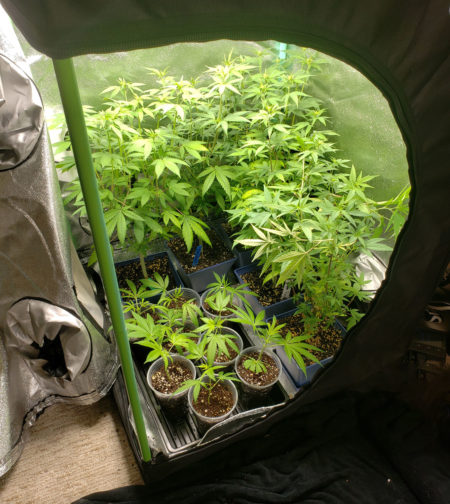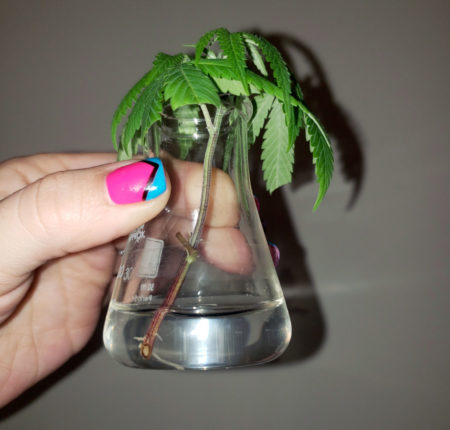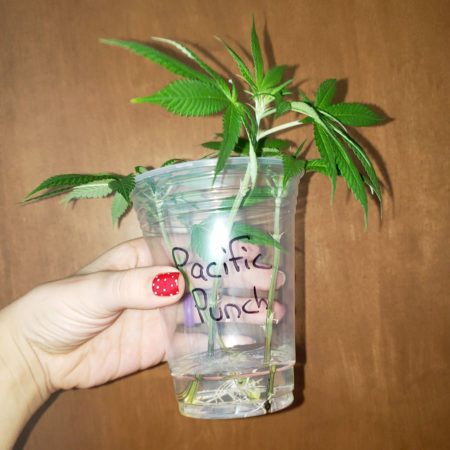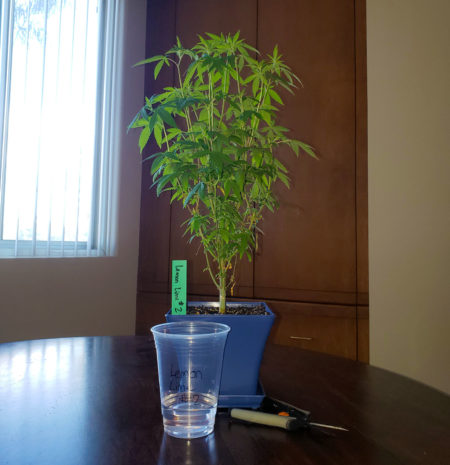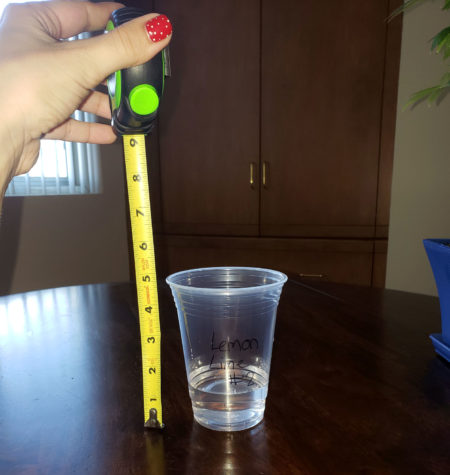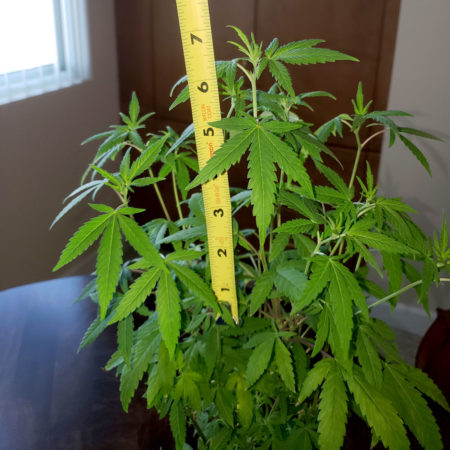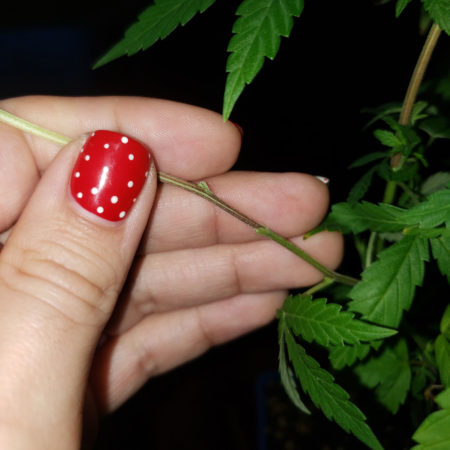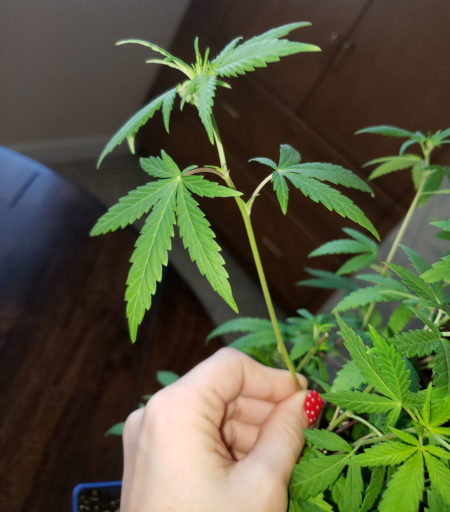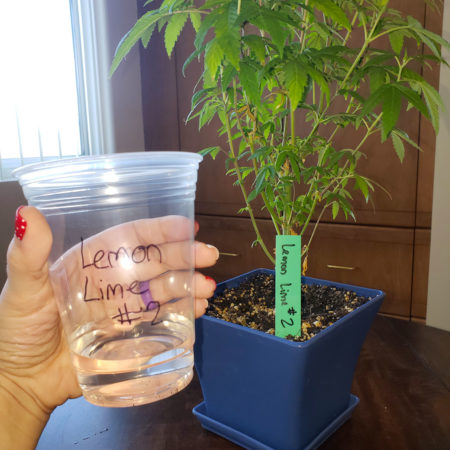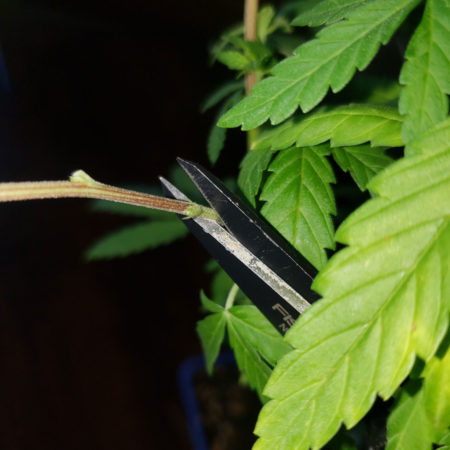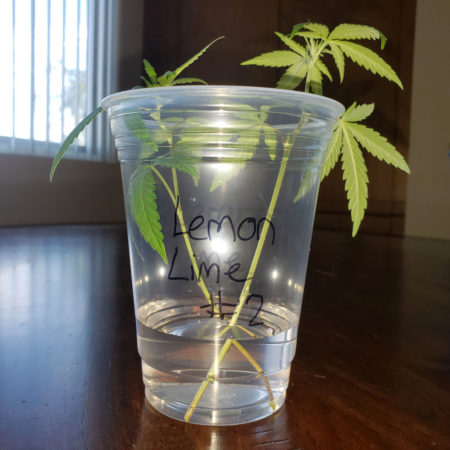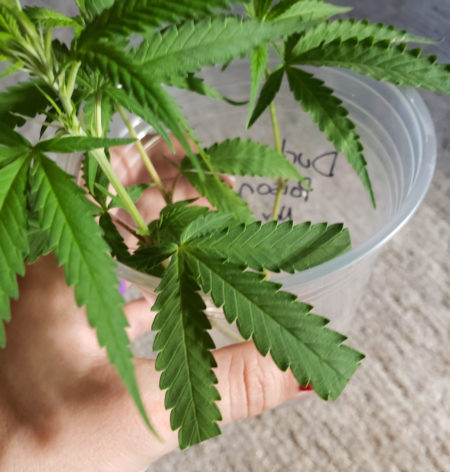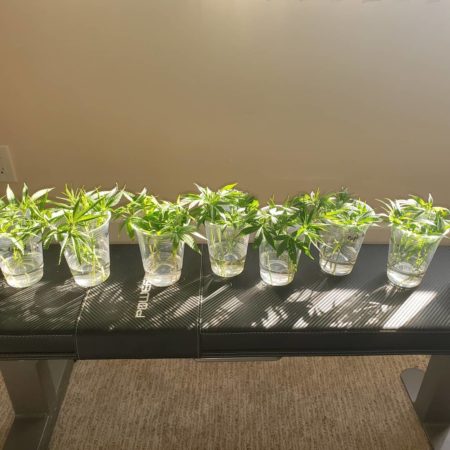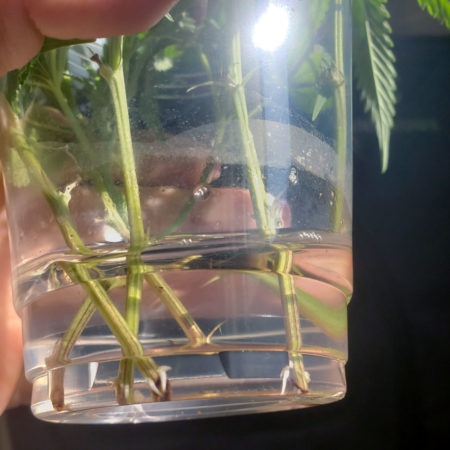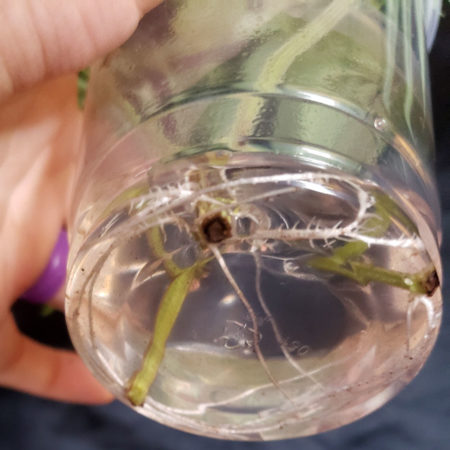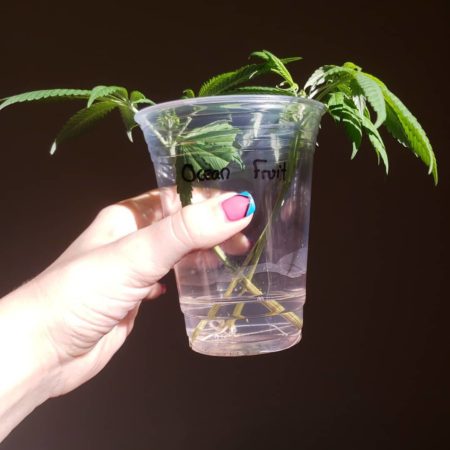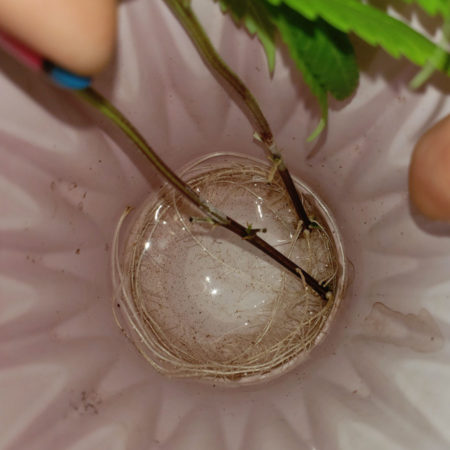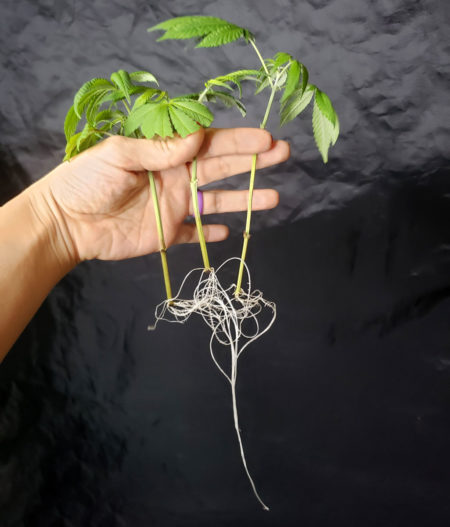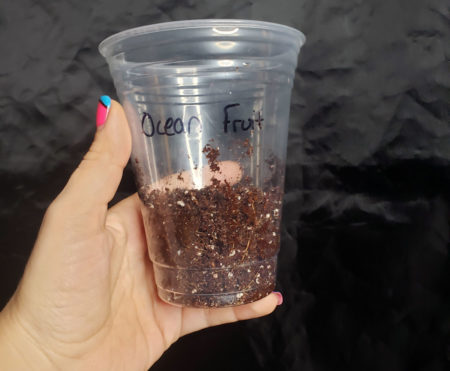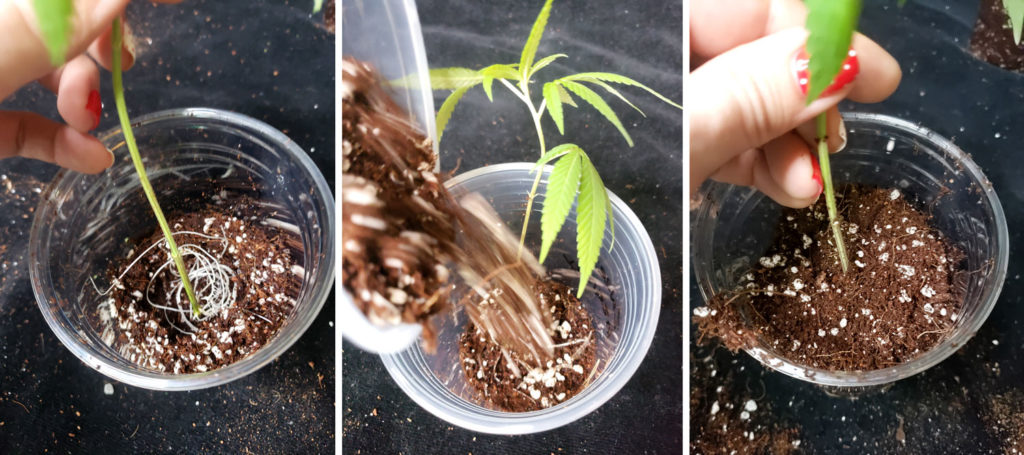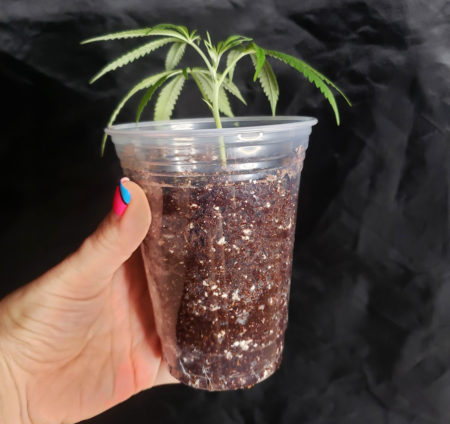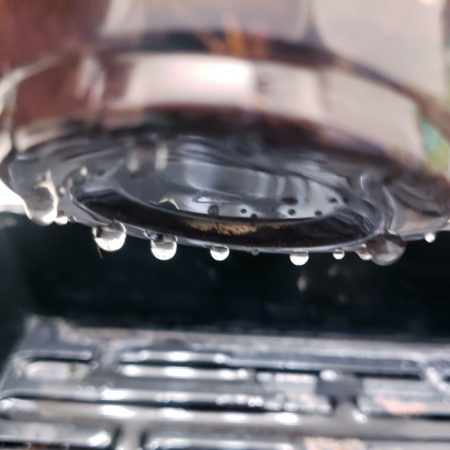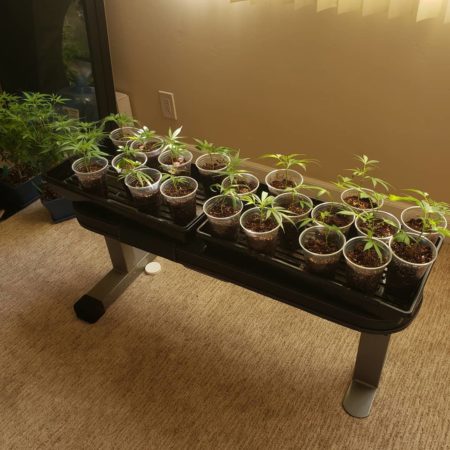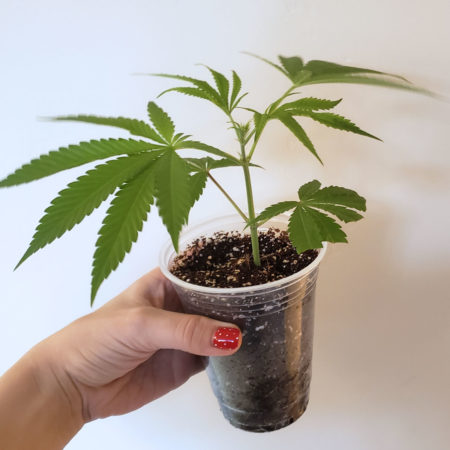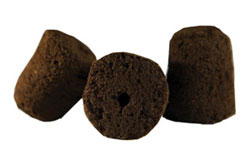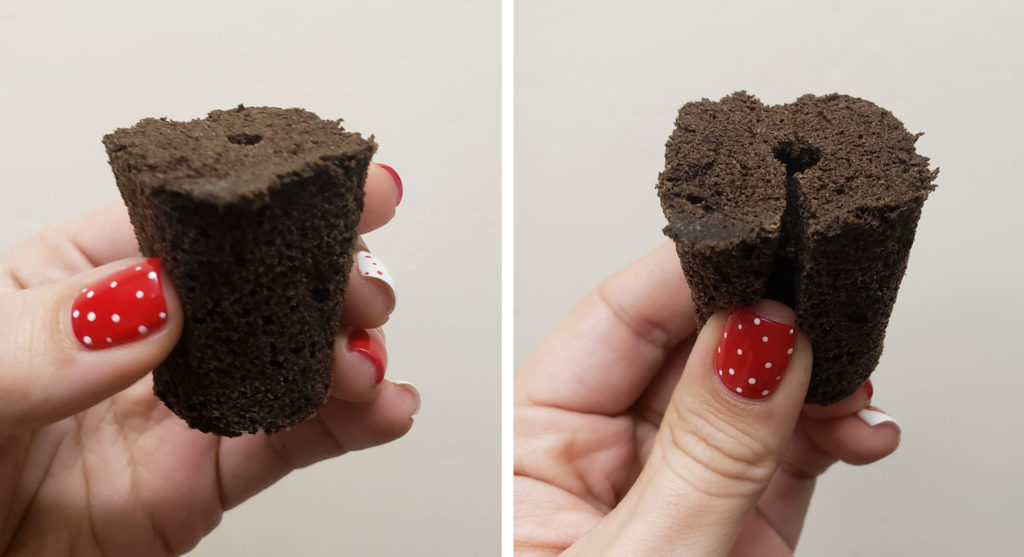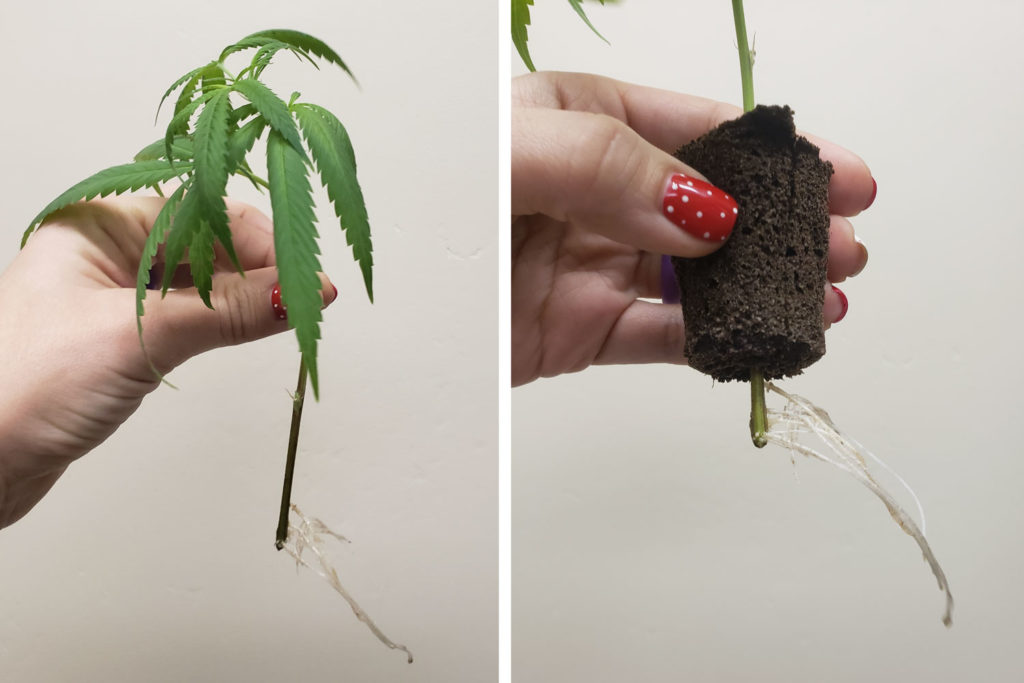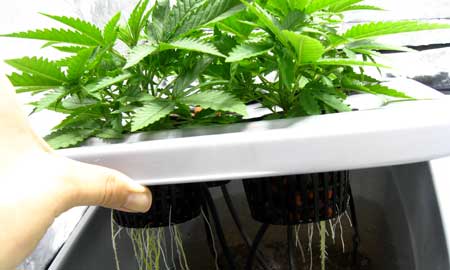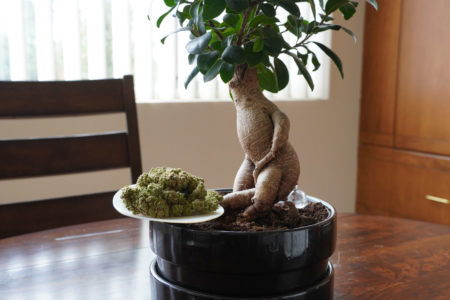by Nebula Haze
Did you know you can clone cannabis by putting a piece of a branch in water? Just leave your cup in a warm sunny spot and wait 2-4 weeks for roots to form (some strains take longer with this method, while others root quickly).
Who doesn’t want a bunch of free plants when it’s this easy?
Roots form in 2-4 weeks on average (some strains make roots faster than others, and some stubborn strains take longer than 4 weeks)
Put a rooted clone in soil, coco, or hydro, and you’ve got a new free plant!
Each of these cuttings is an exact copy of the “mother” plant. As a result, you know that all these clones will grow pretty much the same as each other (and their mum). Cloning is also a great way to produce a lot of plants at once for basically free. If buying seeds is too expensive (and creating your own seeds isn’t feasible), then cloning can make growing cannabis a lot more affordable. Cloning via the “cup method” is easy and doesn’t take much space, effort, or equipment.
This tutorial will teach you how to make rooted clones like this in a cup of water (it’s easy!)
How to Clone Cannabis with the Cup Method
This section will take you through the process of cloning step by step. First, you will need a few supplies…
Supplies list
- A cannabis plant with at least 7″ long branches (these stems will become your clones)
- Sharp scissors
- Fresh clean water (spring water is great, but any human-drinkable water will work)
- A cup or container to put your clones in
Supplies needed for this cloning tutorial (cannabis plant, scissors, water, and a cup)
Optional but not necessary
- General Purpose or Vegetative nutrients (FloraNova Grow is a great one-part nutrient for vegetative growth) – add to your water at seedling strength, or just give plain water
- Cloning powder and/or cloning gel
The little plants in this picture used to be branches on the plants behind them. Each is a genetic copy of their “mother” plant.
Will using clear cups hurt the roots? I’ve tried cloning in clear and not-clear cups. As far as I can tell, it didn’t seem to make a difference in rooting rates. I would avoid letting direct light shine on the roots and make the water hot, but a little ambient light doesn’t seem to bother them. After trying it both ways, I personally use clear cups so I can easily see the roots as they form, but any cup or container will work.
I’ve cloned in clear cups and opaque cups like this. Both seem to work great!
You can clone cannabis in basically any cup or container. This clone made roots in a glass beaker after being left on the kitchen counter. However, small clones take MUCH longer to make roots than bigger ones.
Step-By-Step Cloning Instructions
If this is your first time taking cannabis clones, I recommend only taking cuttings from a vegetative plant that hasn’t started flowering yet. A vegetative plant is only growing stems and leaves, but no pistils or buds yet. Plants in the vegetative phase tend to root more quickly and easily. On the other hand, clones taken during the flowering stage may take longer to make roots, and sometimes display odd growth patterns for the first few weeks after rooting. Some people take flowering clones on purpose to take advantage of those growth patterns. This is known as monstercropping but is considered an advanced growing technique.
The goal is to have a rooted clone by the end of the tutorial. Then I’ll show you how to plant your clone in soil, coco, or hydro.
Step 0 – Prepare for cloning
Get all your supplies ready before you get started. Get your plant, your glass of water, your scissors, and put them all in the same place so you can smoothly cut clones and stick them immediately in water.
Prepare your space with your plant, scissors, water, and cups. Don’t forget to label your cup with the strain name!
What about cloning gel or cloning powder? You can dip the ends of stems into cloning gel and/or cloning powder, which may help them root more quickly. Many growers find they help plants root faster, but when it comes to this method, I’ve never really noticed much difference between clones that get dipped vs not dipped. However, it definitely can’t hurt and may help you in your individual environment.
What’s the best water to use? Spring water is my favorite water for cloning (or growing) weed. It doesn’t have all the minerals removed like filtered water or distilled water, and often has a lot less extra random “stuff” than tap water. Plants typically respond well with spring water. That being said, I don’t have the option to use spring water all the time so I use regular filtered or tap water. Our local tap water is not great, with high PH and PPM. Yet it works great for growing and cloning weed as long as I correct the pH. Based on my experience talking to other growers, it seems like nearly all human-drinkable water sources work to grow weed as long as the pH is adjusted to be in the correct range.
If your tap water is good enough to drink, it’s good enough for cup cloning (as long as you correct the pH!)
Should I use nutrients?
You can clone cannabis in straight spring water. However, I personally like to give them a very small dose of nutrients in their water. If you already have nutrients you plan to use during your grow, I recommend using those at what’s listed on the bottle as “seedling strength”. If not, simply use half of what you would use in the vegetative stage. If you’re not planning on using nutrients during your grow (for example if growing in super soil), then it may be easier to stick with plain water for cloning so you don’t have to buy nutrients just for this part.
Step 1 – Identify which branches are at least 7″ (18cm) long on your vegetative plant
For first-time cloners, I recommend cutting clones that are around 7″ (18 cm) tall. That means you need to identify which branches on your plant are at least that long or longer. This size will fit in a typical drinking glass with the leaves able to reach over the top of the glass and “spread their wings” to the light.
Your clones should be big enough to reach over the top of your cup
You can cut a clone that’s shorter than 7″ (I’ve successfully cloned a stem as little as 3″ tall). However, shorter clones typically take longer to root. I had one 4″ cutting that didn’t make roots after several weeks. Out of curiosity, I just let it keep going and refilling the cup as the water level got low. I was amazed when it finally sprouted roots 2 months later. If your stems aren’t long enough yet, follow the tips below to get them to quickly grow longer.
How do I make my plant produce longer stems for clones?
- If the stems on your plant are too short (or there aren’t many suitable clone sites or offshoots), you need to encourage the plant to branch out and give the stems time to lengthen
- If you haven’t yet topped the plant, do it now (cut off the top tip of the main stem). This will cause the plant to naturally bush out and develop more side branches.
- A stem on the plant won’t develop without light. Try to gently open up the plant via bending and tie the tallest branches down so all the small shoots get light and start growing.
- Give strong light to your plant so all the newly-exposed shoots grow quickly
- But not too much light. Make sure to follow the manufacturer’s instructions on how far to keep your grow light from plants. Keeping a grow light too close to the plant can slow down plant growth to a crawl. It also tends to keep branches shorter. Learn how too much light can cause light stress.
- Make sure to deal with any problems so your plant grows as fast as possible
- If you follow these instructions, it should only be a week or two before you have several suitable clone sites.
This stem is 7″ long. Perfect!
What about bigger/taller clones than 7″? You can definitely take big clones. I’ve seen some growers take 12″ (30 cm) clones or even bigger, especially when using an aerocloner. Big clones can root in the right environment and one advantage is the plants are already well developed. If you’ve got long branches and want a bunch of tall plants right away, you can often turn those branches into big clones. However, bigger clones can be more likely to wilt immediately because they have a difficult time getting water to their tallest leaves and branches. The other issue with big clones is they already have a set stem structure. With smaller clones, you have the ability to shape the size and shape of the clone via plant training, which can dramatically increase your overall yields indoors under a grow light.
Step 2 – Trim the branches until there are only the top two pairs of leaves
You’re cleaning up the stems so you don’t have leaves sitting underwater in the glass. It’s easier to clean the sides of the stem now than after the clones have already been cut.
Trim the branches in preparation so they’re mostly smooth
I typically leave the top two pairs of fully formed leaves, but each clone is a little different. Make sure there are at least a few leaves left!
Step 3 – Cut off your clone and immediately put in water
It’s go time! You are about to cut your clones!
Don’t forget to label your cups with the name of the strain because it’s easy to forget which is which.
Try to cut at a 45-degree angle, and make your cut near a node/set of leaves if possible (this may help clones root faster)
Immediately place your new cuttings in water. Don’t wait or the clone may die!
The longer you wait after cutting before putting the stem in the water, the more likely air will get in the stem. Air in the stem causes the clone to immediately droop and start dying. That’s why the new cutting must be put in water immediately (just like when cutting flowers or roses for a vase).
Note: If using cloning gel or powdery, quickly dip the end of the stem first then place in water. Some growers dip in gel first, then powder, then into the water.
Some growers trim the edges of their leaves, especially big leaves. This is because the cutting has trouble getting enough water to the leaves without any roots. That’s why it’s also a good idea to trim leaves if it’s very dry where you live (the leaves evaporate water quickly in dry air, and the plant can’t keep up). It can also help to raise the humidity or use a dome to keep more moisture in the air around clones.
Trim the ends of leaves if they’re big, or if the air is dry (under 30% RH) where you live. Otherwise, feel free to leave them alone.
Step 3 – Place new cuttings in a warm bright spot to make roots
WARNING: Make sure cuttings get at least 16+ hours of light per day or they will start flowering (making buds). Even a small lightbulb is good.
I have a sunny window that gets really warm, and that’s where I like to put the new cuttings. For the first two days, I leave the blinds mostly closed so they’re getting filtered light. After two days I’ll open the blinds and the window so they’re getting direct sunlight for part of the day.
- Keep clones warm and humid. Roots form much slower if the air is cool or dry.
- Give filtered light for 2 days at first so they have time to adjust
- Then move cuttings to a bright spot with direct-but-not-intense light (for example in a sunny window or under a fluorescent grow light)
- If you notice the water level getting low, gently top off with plain water by pouring water down the sides of the inside of the cup
- Make sure plants get artificial light (like a light bulb) after the sun goes down too, for a total of 16+ hours of light a day (to prevent plants from flowering)
Should I change the water or just leave it alone? Some growers change the water every day when cloning in a cup to help oxygenate the water, but I personally don’t do that and I’ve never had a problem getting roots to form.
This sunny window is my favorite spot for cup cloning. I angled the blinds so these newly-cut clones get filtered light for a few days before getting full sun. Make sure plants get 16+ hours of light a day to prevent plants from flowering (a light bulb is usually enough after the sun goes out)
Step 4 – Roots typically form within 2-3 weeks
If you’ve followed all the directions here, your cuttings should stay upright and healthy-looking the whole time. After about 2 weeks you may start seeing roots on some plants.
Plant roots look like little nubs at first
They soon develop into more recognizable roots
It’s normal if you notice the bottom of your stems turn brown. That’s just part of the process.
Different plants/strains root faster than others. I had an Ocean Fruit plant where every single cutting rooted within 10-12 days. That plant apparently loves being cloned via this method. However, certain plants/strains are just harder to clone than others. I had a Durban Poison plant that took 4 weeks before its cuttings started making roots. All the other plants had rooted all their clones before the first Durban Poison clone made roots. So if your clones are taking a long time to root, it may have nothing to do with you.
Most plants will have roots within 2-3 weeks, however, it’s normal for some cuttings to take longer than others even from the same plant. You may have some cuttings show roots at week 2, while others from the same plant show their first roots in week 4. It’s a matter of patience. I personally like taking many more clones than needed so I can keep the ones that root first. Those tend to be the fastest-growing plants anyway!
Pay attention to your clones! I completely forgot about these and when I checked on them the roots were grown together and almost all the water was gone!
If your roots grow together, they often can be untangled. Treat them as if you’re gently untangling a knot in someone’s hair. Tug softly and slowly on first one strand, then the others, giving the strands time to unravel and separate from each other. Don’t pull hard or they’ll break!
Now that you have rooted clones, it’s time to install them into their next home.
Not sure whether to put your newly rooted clones in soil, coco, or hydro? These clones can be used with any grow medium including hydroponics. Once the cuttings have made roots, you install them in your grow medium or hydro reservoir and start treating them like small plants. If you’re looking for a suggestion on the best grow medium for beginners, I’ve had consistently great results with both Coco Loco (soil-based) and Mother Earth Coco + Perlite mix (soilless).
How to Plant Your Rooted Clones in Soil or Coco
1.) Fill your cup half full (or make a 4-5″ deep hole wherever you plan to plant your clone)
2.) Add a little water to the grow medium until it is wet but not soaking, then press down slightly to make a small divet or hole for your roots to fit inside.
When planting your newly rooted clone into a grow medium, you basically want to wet the potting mix first and press down to make a slide indent for your roots.
3.) Gently place your root into the indent you created. If the root is long, you may need to wrap it around in a circle. Avoid using any force, but the roots are pretty flexible.
Having an indent will help keep your roots from touching the sides by giving you an outside “edge” to wrap your roots inside.
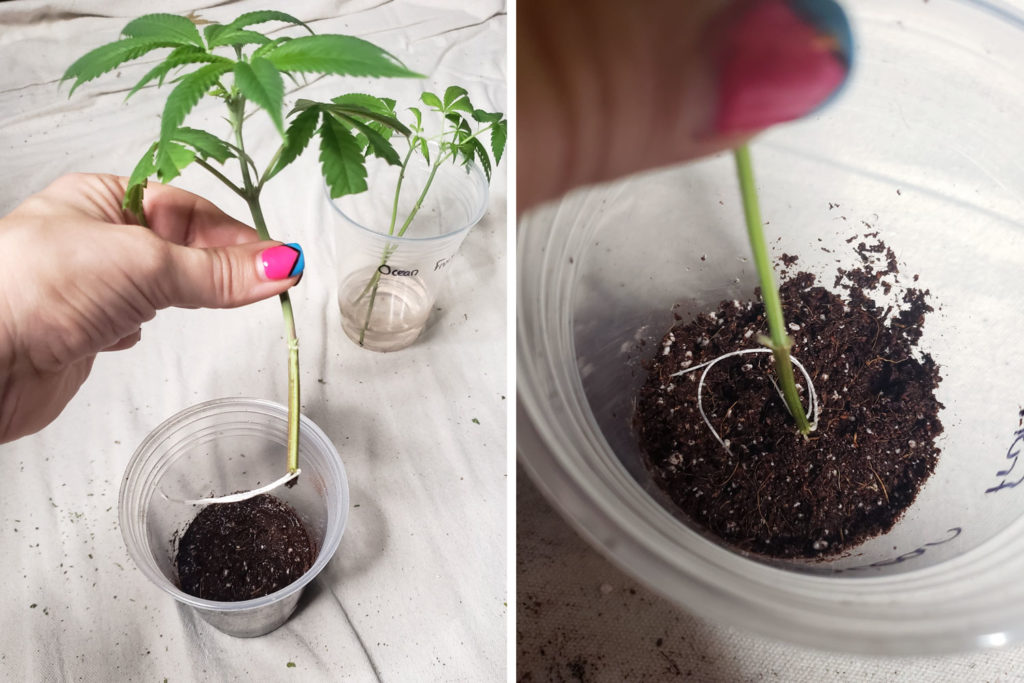
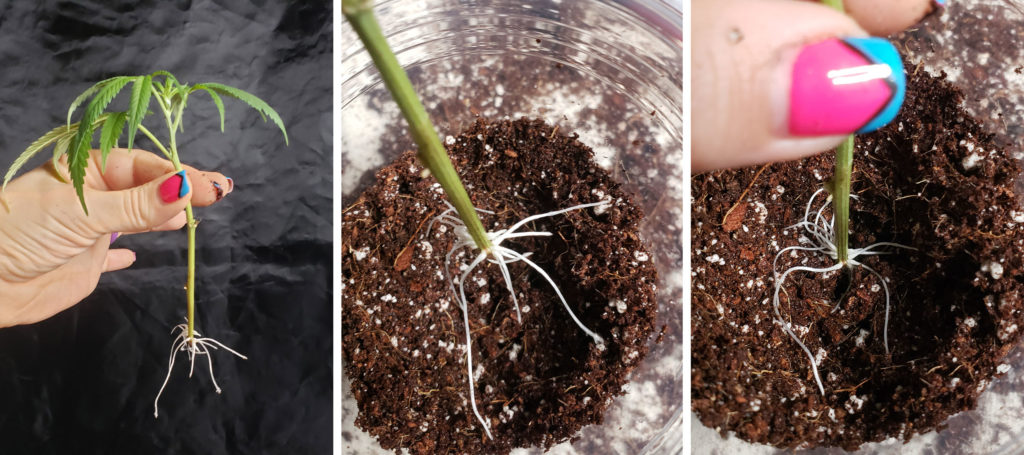
4.) Fill the rest of the cup with soil and give a thorough watering.
Try to keep the clone in the middle and upright, but if it’s a little crooked it’s okay. Once the plant is a bit bigger you likely won’t be able to notice.
Try to hold the stem steady in the middle as you fill the cup with soil or coco
Fill to almost the top of the cup with potting mix and then add more water until moist all the way through
5.) Make sure extra water can drain out (plants love good drainage!)
Don’t forget to cut holes out of the bottom so any extra water can drain out. Roots like it wet but not soaking.
I used scissors to cut slits around the edges of the bottom of this cup in order to let any excess water drain out
6.) Give gentle light at first. I leave them in the filtered light of a west-facing window. If you put them under direct light immediately, they can droop or wilt. Once they’ve acclimated to their new home for a day or two and still look happy and healthy, you should be able to start giving them direct light. Within a week it should be growing fast and happy.
7.) Enjoy your new plants!
How to Plant Your Rooted Clones in Hydroponics
Placing these rooted clones in hydroponics is simple and quick. You could plant your clone directly in the clay pebbles, but the following system makes it a bit easier. You probably already have seedling plugs in your grow room if you’re growing with hydroponics.
1.) Get a seedling plug such as Rapid Rooters (or whatever plugs you typically use with your system).
This will be used to hold your clone and keep it anchored where you want.
Any seedling plugs will work to install your clone, but I personally like Rapid Rooters for hydroponic setups
2.) Cut the plug open lengthwise
Take your seedling plug and cut it open lengthwise.
3.) Wrap the plug around the stem of your rooted clone.
Wrap the plug around the stem. This supports the stem so it’s stable and easier to install into a hydroponic system
4.) Install the plug into your hydroponic system just like you normally would. Thread the roots through the bottom holes of your net pot (or cut a hole in your net pot for the roots if they’re too big) and fill in the rest of the way with hydroton to hold seedling in place.
Make sure there is at least an inch of air underneath the very bottom of the stem. You don’t want the water level coming up to the actual stem or it tends to get mushy and hurt the plant (same with seed-grown plants). Whenever growing cannabis in hydro, always give roots some air to breathe before they touch the water. Oxygen makes the plants grow faster and helps prevent root problems. As long as you have lots of bubbles in your reservoir, you should have enough water splashing up on the roots that they stay moist even though they’re above the water line. The roots will grow longer until they’re actually dangling in the water, and that’s when clones really take off!
Learn more about growing in hydroponics
Once the roots hit the reservoir your plants will take off!
Plants are so cool!

